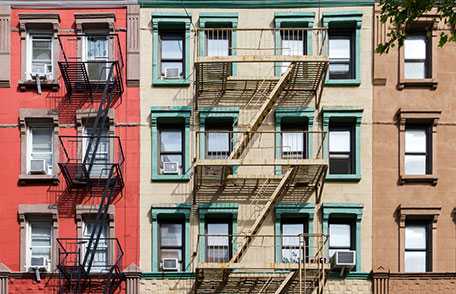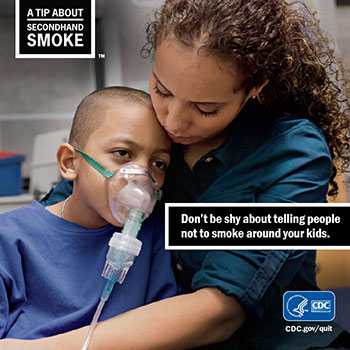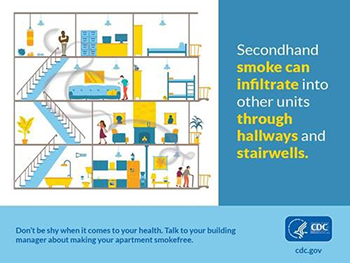Everyone Deserves a Smokefree Home

Make sure your home is a safe place to breathe.
You and your family deserve a safe and healthy home, free from all environment hazards. One way you can ensure the health and safety of those in your household is to not smoke tobacco products or allow others to smoke these products inside your home.
Secondhand Smoke is Harmful
Secondhand smoke exposure causes disease and premature death in nonsmokers. Completely eliminating tobacco smoke indoors is the only way to fully protect those in your household from this preventable health risk.
Smokefree Housing Policies Benefit Everyone
In buildings that have multiple housing units, secondhand smoke can move from unit to unit through hallways and stairwells. More than one in three nonsmokers who live in rental housing are exposed to secondhand smoke. And many who live in public housing are especially vulnerable to the effects of secondhand smoke, including children, the elderly, and people with disabilities.
The U.S. Department of Housing and Urban Development (HUD) set up a smokefree rule that became effective for every U.S. public housing agency in February 2017. This rule prohibits lit tobacco products (e.g., cigarettes, cigars, pipes, and hookahs) in all living units and indoor common areas in federal multiunit public housing buildings. The rule will cover the nation’s 1.2 million public housing units, thus protecting the more than 2 million people who live in these units from the risks of secondhand smoke exposure in their homes, including over 760,000 children.
In addition to public housing, owners and operators of other types of multiunit housing can also consider smokefree policies to ensure that even more people will enjoy the benefits of smokefree air in the places they live, gather, and play.
Smokefree policies in multiunit housing improve the health of people like Aden, whose severe asthma is triggered by exposure to secondhand smoke. Aden’s mother, Jessica, encourages others to keep their children away from secondhand smoke in the video, Jessica’s Asthma Ad, from CDC’s Tips From Former Smokers™ campaign.


In multi-unit housing, secondhand smoke can enter into other units through hallways and stairways.
How Secondhand Smoke is Harmful to You
The dangers of exposure to secondhand smoke are real—secondhand smoke kills more than 400 infants from sudden infant death syndrome (SIDS) and about 41,000 nonsmoking adults from heart disease and lung cancer every year. About 58 million nonsmokers in the U.S. are still exposed to secondhand smoke, many of whom are exposed in their homes. (See Secondhand Smoke: An Unequal Danger, CDC Vital Signs [6.14 MB]).
Tips for Maintaining a Healthy, Smokefree Home
- Start a household rule that prohibits anyone from smoking tobacco products inside your home at any time.
- Support your family and neighbors who might need help to quit smoking.
Resources to Quit Smoking
If you or someone in your household smokes, free resources for quitting are available:
- 1-800-QUIT-NOW (1-800-784-8669) or 1-855-DÉJELO-YA (1-855-335-3569) (for Spanish speakers) -This free service offers many resources, including coaching, help with making a quit plan, educational materials, referrals to other resources where you live, information on FDA-approved cessation medications, and, in some cases, free or discounted cessation medications.
- Smokefree TXT—This free 24/7 texting program sends encouragement, advice, and tips to help smokers quit smoking for good. To get started, just text QUIT to 47848, answer a few questions, and you’ll start receiving messages.
- Online help—This Tips From Former Smokers web page provides helpful online quit resources.
- Smokefree App—The QuitGuide is a free app that tracks cravings, moods, slips, and smokefree progress to help you understand your smoking patterns and build the skills needed to become and stay smokefree.
- Smokefree.gov—This site has information and professional assistance to help you or someone you care about quit smoking. Choose the resource that best fits your needs.
More Information
- HUD’s Healthy Homes webpage includes information and free resources on enjoying a safer, healthier home, including the National Healthy Homes Month Planning Guide and the Smoke-Free Multi-Family Housing Resource Bank.
- CDC’s Healthy Homes Manual: Smokefree Policies in Multiunit Housing [6.99 MB] offers strategies, recommendations, and best practices for smoke-free living.
- CDC’s Vital Signs publication [2.93 MB] highlights the harms of secondhand smoke exposure.
- The CDC infographic Going Smokefree Matters – Multiunit Housing provides more information about secondhand smoke within multiunit housing.
- CDC’s Smokefree Quit flyer [2.94 MB] is available for anyone to post in common areas of their property.
- CDC’s booklets, Secondhand Smoke: What It Means to You [11MB] and How We Can Protect Our Children from Secondhand Smoke are available to further educate consumers on the effects of secondhand smoke.
- The American Lung Association’s website includes an online curriculum, Smokefree Policies in Multi-Unit Housing: Steps for Success, which describes how to implement a smokefree policy in multiunit housing properties. Their site also features an initiative, Expanding Smokefree Communities, which includes case studies, videos, and other information on smokefree housing, including public housing.
- Page last reviewed: June 26, 2017
- Page last updated: June 26, 2017
- Content source:
- National Center for Chronic Disease Prevention and Health Promotion, Office on Smoking and Health
- Page maintained by: Office of the Associate Director for Communication, Digital Media Branch, Division of Public Affairs




 ShareCompartir
ShareCompartir